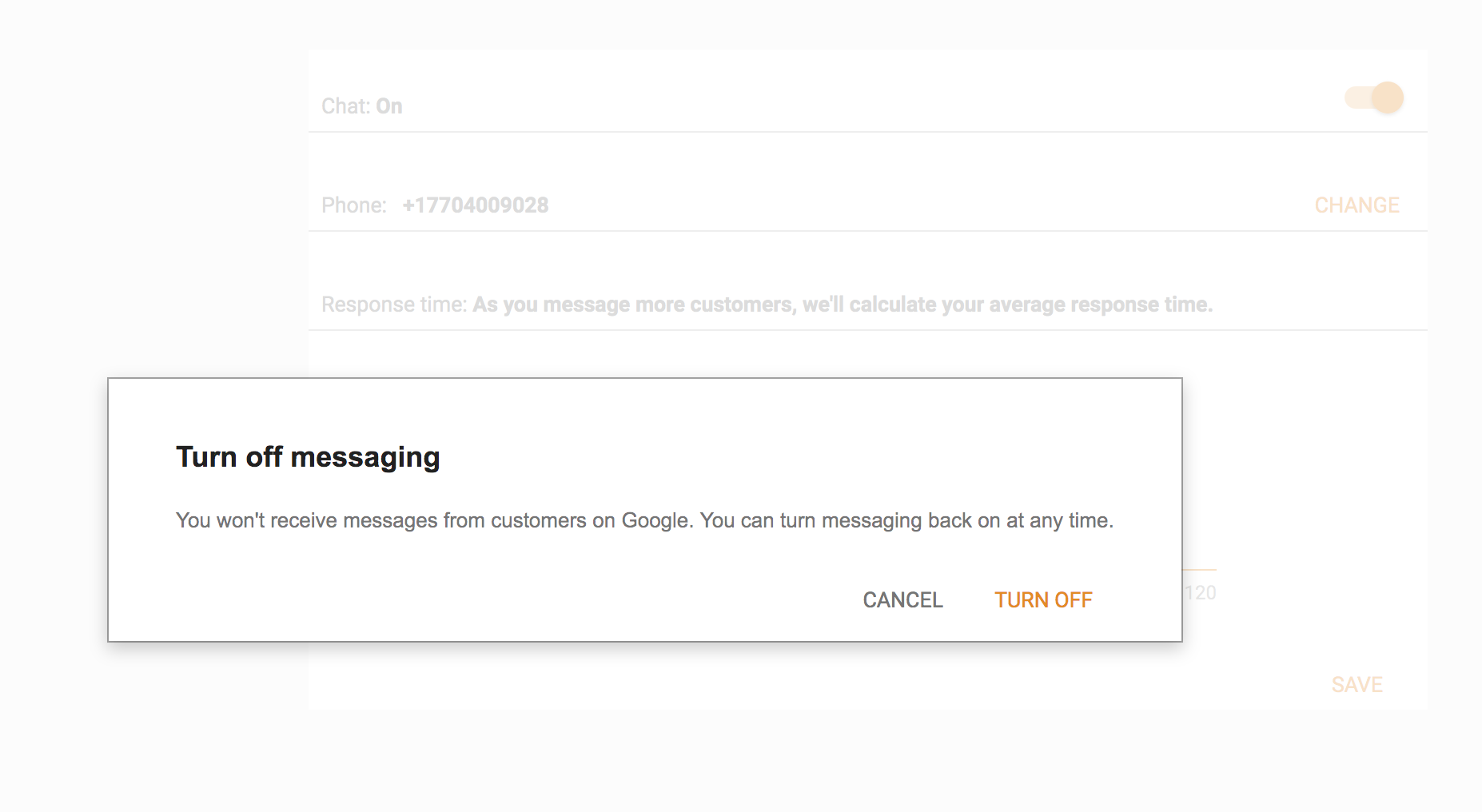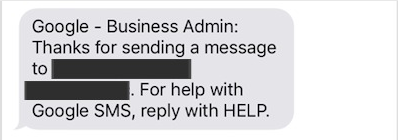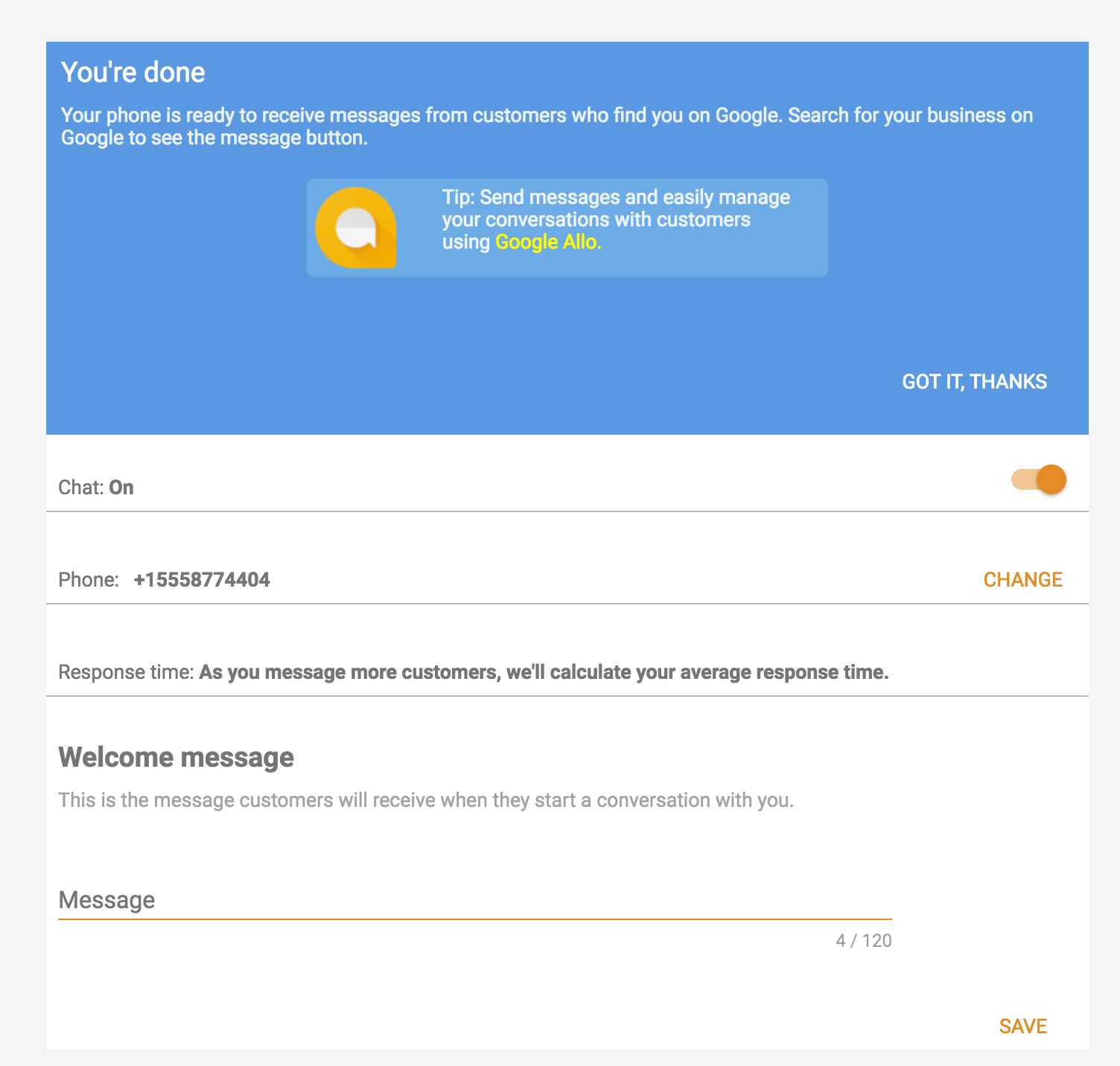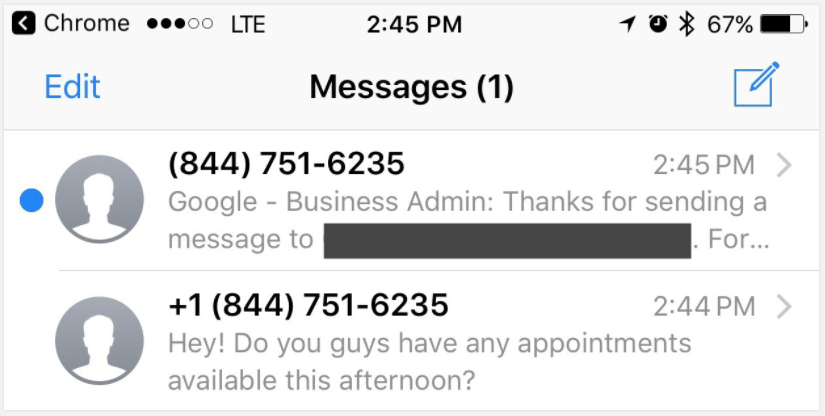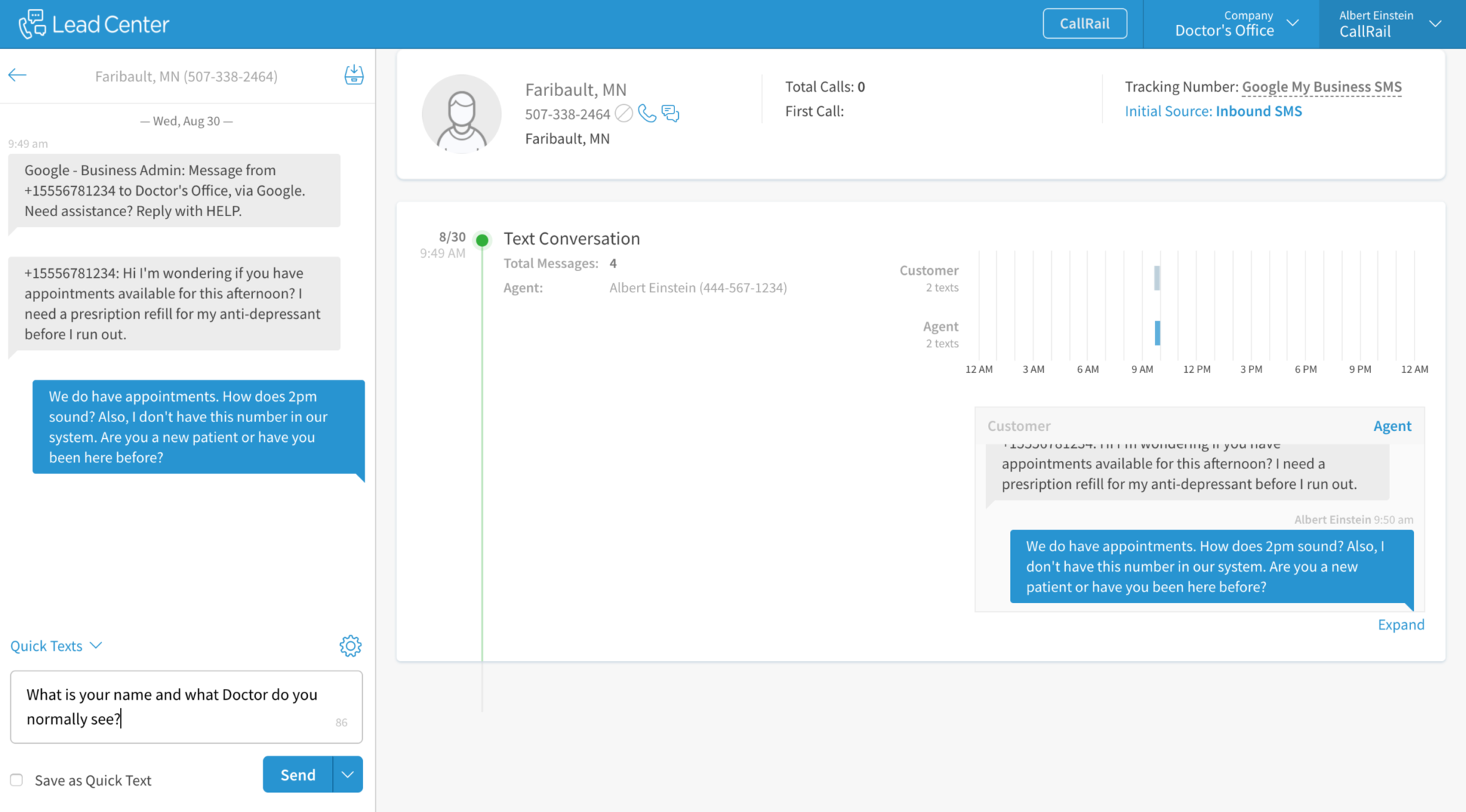Last month, Google announced that businesses could choose to participate in messaging directly from their Google My Business (GMB) profiles. This option allows local businesses to connect directly with searchers to answer questions and potentially attract more in-store visits and conversions. In theory, the messenger is a huge step forward for more direct, search-to-business communication with small and location based businesses. In practice, Google’s current iteration of its messenger leaves much to be desired in terms of user experience and raises serious concerns around privacy, especially healthcare laws that govern patient-provider communications.
GMB Messaging Attempts to Provide Value to SMBs
On the support site, Google frames GMB messenger as a way for businesses to expand communication with new and returning customers: “Responding to customers can help you answer their questions, tell your business’s story, and attract more people to your location.”
This messaging option gives business owners even more tools to be a click or tap away from their customers, similar to click-to-call functionality that already exists in GMB. People started noticing call reports in the GMB dashboards to track how many searchers called directly from a business listing. Tools like GMB messenger seem to be part of an overarching strategy where Google is trying to provide more value to business owners.
Check out our Ultimate Guide to Google My Business to begin optimizing your listing.
GMB Messenger Aims to Replicate Facebook’s Success
Google appears to be trying to emulate the successful experience some business owners have had with Facebook Messenger on Facebook Business Pages. Many companies have taken advantage of the connection with Facebook Messenger in which consumers can opt in to receive messages such as automatic order and shipping notifications. Consumers can also reply to these messages with questions or issues and get responses from the business Facebook page.
The GMB messenger doesn’t have the same functionality as the Facebook messenger for business (yet). However, GMB does give local businesses the chance to answer questions someone may have before a a lower funnel conversion like an appointment booking or purchase.
User Experience is Lacking for Businesses and Customers
While we can assume Google has good intentions for GMB messenger, the current version of the feature is rather sloppy in practice. For one, the feature is named different things in different places. When you click to turn the feature on, its called messenger. If businesses choose to turn the feature off, it’s then called chat. If you look in the greyed out section of the screenshot below, you can see where it says, “Chat: ON” while the pop-up prompt asks if you want to “Turn off messaging.”
While the mixed messaging (pun definitely intended) of switching between calling the feature messaging/chat may seem minor, it does indicate that the feature may not be as well-thought out as businesses and users expect.
Aside from the two names above, which appear on the business’s GMB admin side, when we tested the feature from the searcher’s side, we noticed a third, separate name for the feature in the initial automated reply: “For help with Google SMS, reply with HELP.”
So what is it? Is it messaging? Is it chat? Is it SMS? Google obviously wants to be in all three spaces, but the mixed naming is confusing.
Stop Trying to Make Fetch Happen
The lack of clear communication from Google spans the feature’s functionalities, as well. As Mike Blumenthal mentions in his excellent Q&A post on GMB messenger, businesses and users can use three options to receive and send messages to customers: “SMS, Allo and something on Android called App Preview Messages.” Blumenthal’s next answer attempts to explain what App Preview Messages is (his recommendation for businesses is to “just stick to SMS.”)
In a similar vein, Android users across the web have given up on Allo, saying Google’s attempt at a “cross platform Android iMessage,” is essentially dead. After a surge of initial downloads, the communication app has failed to gain much traction.
And yet, Google made Allo and App Preview Messages two of the three ways to use the feature. There’s also little clarity on the business side regarding how it will work or explanations of what Allo or App preview are for people who don’t use them.
Adding to the confusion, Google allows businesses to set up a “welcome message” for customers to receive “when they start a conversation with you” that doesn’t quite work as expected.
Many business owners using Facebook Business Pages would be forgiven for thinking the welcome message in GMB would behave like Facebook Messenger’s “instant replies”. In a post for MarketingLand about the expanding featureset for Facebook’s business messenger offering, Greg Sterling explains instant replies as “automatic [responses] and can contain any message from the Page owner (e.g. ‘thanks for your inquiry, we’ll get back to you within 24 hours’).”
The help text next to the welcome message in GMB implies that it would come through when the customer initiates the conversation. When we set up the welcome message in our testing, we assumed it was the same as the Facebook instant reply. However, when we tested it, the welcome message never appeared. Instead our user just got a the strange welcome message from Google SMS. Looking into it further, we assume the welcome message would appear on Allo or the mysterious App Preview Messages (neither of which we’ve ever used.)
Business-Side Phone Number Confusion
While setting up the feature is a bit of a confusing mess, using it is just as complicated. In actual use, you’d think that businesses would be able to use this chat feature as a precursor to, or in tandem with, getting more phone calls. Imagine a user trying to make reservations for a restaurant:
User: Hi, do you have any reservations still available for 7pm on Saturday?
Business: Hello! We don’t have a 7pm, but we do have 6pm and 8pm available. Would either of those work for you?
User: Ok, I’ll take the 8pm.
Business: Perfect. May we call you to get the details?
User: Yeah. Just call this number.
Score for this business! Except “just calling this number” is not as easy through the Google My Business messenger setup. The messages come from an unknown number and the customer’s actual phone number is given to the business in the body of the very first text message.
The business owner would have to scroll to the top of the text message thread, copy the number, open a dialer, paste the number and call the customer. Not exceptionally intuitive, although probably worth the pain for most businesses. From the searcher’s side, however, the phone number confusion is much more of a problem.
Searcher-Side Phone Number Confusion
The business side of the GMB messaging feature is not perceptive regarding business needs or lead follow up, but the searcher side is just plain strange. We know searchers can readily see and call the business’s actual phone number from a GMB listing that appears in search. However, when they opt for messaging the company, GMB messenger uses a Google forwarding number that is neither the number a business verifies to use with the feature or the business’s main phone number on GMB. In our tests the Google forwarding number also had a different area code than the business and searcher.
This in itself might be a barrier to entry for certain users who may not know that Google is assigning a Google forwarding number to this SMS feature. Again, Google also labels this messenger feature as “Google SMS” in its auto reply, which isn’t explained to the searcher and is completely different from how GMB’s click-to-call feature works. Perhaps many searchers won’t mind that what they think are private, direct messages to a business are going through Google, but it struck us as surprising and very odd.
The mismatch of numbers is even more confusing when replies to inbound texts come in through a new text message thread without +1 on initial text to number:
Just like on the business-side, when the searcher tries to call the number with which they’re texting, the call does not go through. They receive a the message: “We could not complete your call. Please try again.”
Imagine a business replying to a message and asking for a phone call: “Give us a call and we’ll get you booked.” Users are likely to just call the number with which they’re texting. It makes the most sense as a user as that’s how we operate with our phones during any other interaction. Text message conversions often lead to one party just calling the other to finish ironing out details or to explain something further. Calling, receiving that error message, trying to find the right number, and so on– is an awful experience for the searcher/prospective customer.
Larger Questions, Privacy Concerns, HIPAA Compliance
The forwarding number issue and lack of consistent branding may seem like nitpicky aspects to worry about in a new messaging feature. However, these small issues are part of larger problems with this GMB feature–a lack of cohesion, communication, and consent about how it works. Specifically, there is no explicit searcher opt-in for Google to collect data or see business-user text messages.
We tested this feature with a local doctor’s office, and the first thing we noticed was there was no HIPAA warning, which brings up serious concerns about HIPAA compliance when text message interactions with doctor’s offices are very likely to contain PHI (Protected Health Information). Under HIPAA laws, the handling of PHI is strictly regulated to keep it private (both in a information security sense and legal sense).
However even for non-healthcare businesses, GMB messenger offers no explicit explanation that a searcher can’t call the number they’re texting and that a separate 3rd party number would be used instead of the number a business has verified. Employees who set up the messaging feature may believe that searchers get the same number that shows up as the click-to-call option on their GMB listing–not knowing that a forwarding number is involved. This means that even businesses with good intentions who want to make their communication with customers private, legal and compliant may not know that interactions via GMB messenger pose risks.
Where Google Can Improve
It’s likely that some of the poor user experience issues will likely be addressed in future updates. Blumenthal’s Q&A reveals that there are quite a few elements of the feature that Google is looking to fix: the forwarding number not being local to the client and the ability to make calls on the SMS numbers.
Google’s forwarding number option makes sense in theory if a business uses a landline without messaging capabilities for their main GMB number. If that were the case, a user could have added a mobile phone number to the messenger option that’s different from the business number listed on GMB. Regardless, the communication about the displayed numbers should be more evident to businesses and searchers.
Along with communication regarding exactly how the feature works, hopefully other issues like the sloppy naming conventions will also be addressed.
The GMB messaging feature might even be rolled back as more people bring up privacy and HIPAA-type concerns with Google inserting their own telephony into these communications. They might first remove the feature for healthcare-related businesses and other businesses that are more likely to have sensitive information exchanged in these interactions (such as lawyers, nursing homes, etc.)
Recommendations for Businesses
- For healthcare businesses or companies with sensitive info that needs to be protected:
Assuming the poor user experience and clunky lead follow up are not deal breakers, we still do not recommend using the GMB messaging feature until more information or improvements are released that proves these communications pose no risk to your business.
- For businesses that are already tracking text messages with a text-enabled tracking number:
We highly recommend you know and test how GMB messaging will work with your existing lead management and follow up. You should also confirm that the user experience is fitting with what you want your customers to expect from interactions with your business.
If you decide to use the feature, we recommend you need set up a separate GMB text message tracking number to keep these interactions off your or your staff’s mobile devices and in a place you can see & follow up, similar to CallRail’s Lead Center.
- For all other types of businesses:
We recommend you make certain you know where the text messages will go, and make sure you’re okay with that. Right now you can only verify one phone number at a time to receive these messages. Will your single number be the mobile phone of one staff member? Will you change the number based on days certain people are on “duty” to respond to messages? It’s something to consider to make sure you follow up with inbound leads in a timely, consistent manner.
Bottom Line: Business owners who want to take advantage of GMB messaging should understand the potential privacy issues with the feature as it exists today and accept or mitigate the limitations, odd user experience, and general clunkiness of how to manage leads with it.




